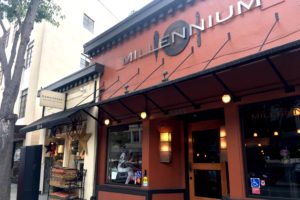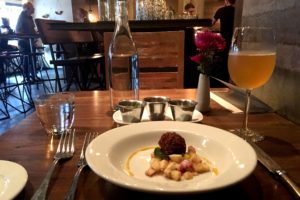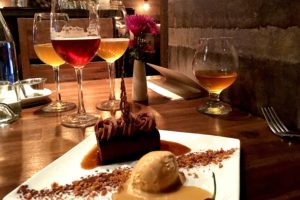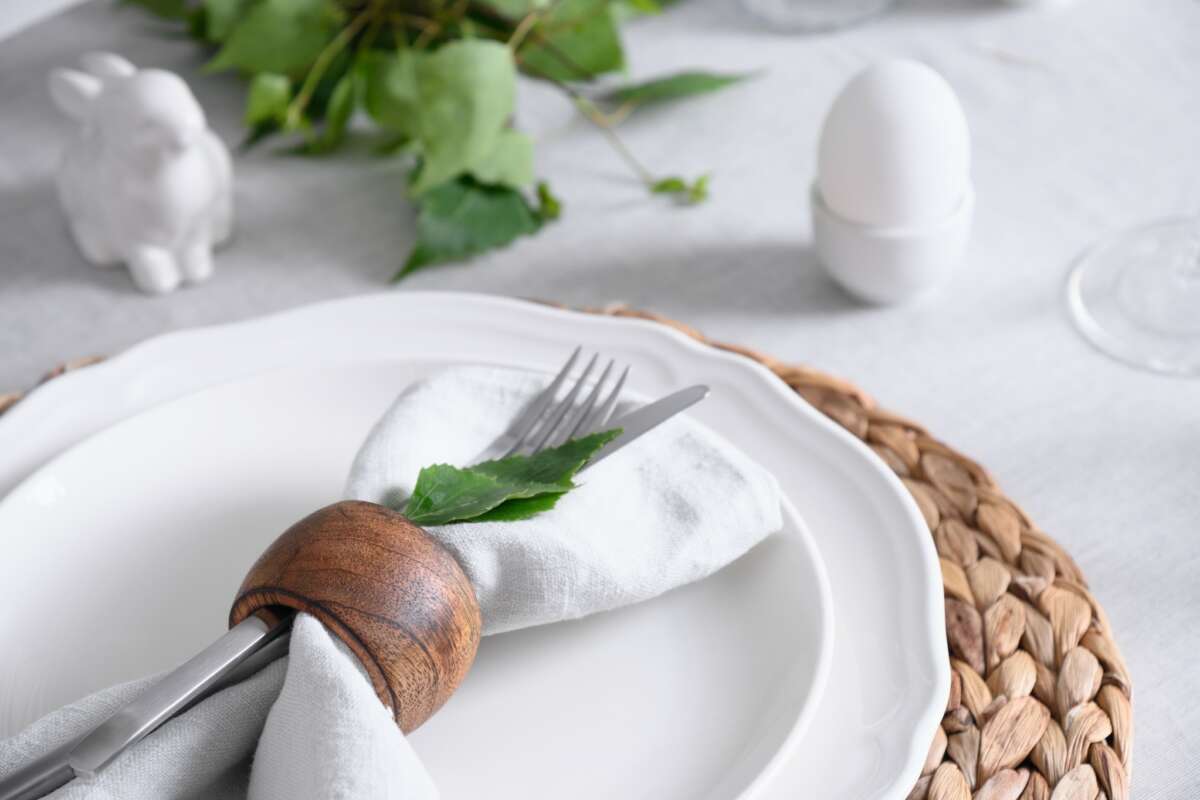Steak or salad? Or to be more precise, steakhouse or vegetable-forward? Which provides the most luxurious experience? Sure, in the past, steakhouses were the ne plus ultra of fine dining – martinis, jumbo shrimp cocktail, a huge hunk of charred beef, and creamed spinach. That was what you ate if you were in the global power elite, circa 1980. But what about now? With so many vegan, vegetarian and vegetables-first gourmet fine dining establishments having opened up shop in so many of the world’s glittering cities, here at Dandelion Chandelier, we decided to go on a quest to answer this pressing question. Our first field report was from Restaurant Nix in Greenwich Village. It’s the only vegetarian restaurant in the US with a Michelin star, so we thought that would be a good place to start. And it was.
But what about the rest of Team Salad? Could they truly compete as luxurious destinations with their beefy brethren in this friendly rivalry? Our travels recently took us to the Bay Area, and we thought there could be no better place to explore the world of vegan fine dining than the place that arguably started it all. If anyone can fully satisfy a lifelong omnivore with a vegan meal, surely that chef resides in Cali.
 Which is how we found ourselves at Millennium in Oakland on a lovely mid-September evening. Last year, we wrote about the best restaurants in Oakland. When we asked about vegan and vegetarian options in town, we got lots of suggestions, and this was among the top ones. Even the carnivores said they liked it. So we decided to give it a whirl.
Which is how we found ourselves at Millennium in Oakland on a lovely mid-September evening. Last year, we wrote about the best restaurants in Oakland. When we asked about vegan and vegetarian options in town, we got lots of suggestions, and this was among the top ones. Even the carnivores said they liked it. So we decided to give it a whirl.
When we made our reservation, we learned that the only night we were available to dine there happened to be the night of their annual Chile and Beer Dinner – a prix fixe 5-course vegan meal featuring chilies from Tierra Vegetables Farm, with the option to pair one craft beer, selected by the restaurant’s expert, with each course. Other than a choice of two entrees, everything else was predetermined. Omakase vegetables and beer. Wow.
This is probably a good time to mention that (1) We are lifelong omnivores; (2) we almost never drink beer (we are committed wine and spirits types); and (3) we don’t like spicy food, and chile peppers are not something we would ever seek out on a menu. Like, ever.
But for you, dear readers, we decided to press onward and give it a try. Nothing to fear but fear itself, and all that. We screwed up our courage and set off for Millennium, chocolate bars in our bags – just in case it was a train wreck. ‘Cause we were actually hungry.
Our initial impression, having entered the space, immediately started to put our fears to rest. It’s wonderfully inviting and rustic-chic. The doors were propped open, letting in the golden glow of the early-evening light. Above our heads were exposed wooden beams and ceiling pipes painted dark brown. Before us was a long, wraparound bar, with nearly every stool already full. Tucked into the corners are antique farm implements: a wheelbarrow; a rake; a hoe; a watering can. There are live plants in containers affixed to the walls and perched on top of side tables. If a gentleman farmer designed a restaurant, it would probably look a lot like this.
We received a friendly greeting from the hostess, who kindly asked if we wanted to sit inside, or outside in “the back garden,” which is covered from the elements and supplied with an ample number of space heaters. We took a peek and it’s lovely. But we opted for indoors – those Oakland nights can get seriously chilly and we wanted to focus on the food and drink.
Our table in the main dining room was simple polished wood, with no adornment other than a bud vase holding a small spray of deep purple chrysanthemums, a cream-colored bread plate, simple utensils and an amber napkin with a gold ring. Our booth was upholstered in dark brown linen. Autumn is our favorite season, and the color palette of caramel, chocolate, and spice colors is one of our absolute favorites. Maybe this would be OK after all.
We quickly ordered the beer pairing, although we were tempted by the three featured cocktails: the Peach Pepper Smash (bourbon, muddled peach and fresno chile), the Dirty Tomato (with roasted tomato vodka), and the Chelada de Verano (with ancho chile liqueur and tequila).
Going with the beer option was made easier because Nicole Ermy, the Master Cicerone®, was so charming. What is that, you say? We didn’t know either, until she told us. It’s the fourth and highest level of the Cicerone Certification Program, and requires the holder to pass a two-day exam with a score of 85% or more. It recognizes “an exceptional understanding of brewing, beer, and pairing — combining outstanding tasting abilities with an encyclopedic knowledge of commercial beers,” according to their website. Clearly, the woman knows her stuff.
On to the food and drink! The first course was black eyed pea fritters in mango and Jamaican habanero sauce, tamarind-jicama pohah chutney and mint. The fruity, savory, crunchy combination was delicious. The real surprise, though, was the beer. Fruitlands from Modern Times Beer in San Diego turns out to be one of the lightest and most refreshing beers we’ve ever had. It doesn’t actually taste as if it has any alcohol in it. Nicole explained that it has notes of passion fruit and guava, giving it a slightly sour taste, with some saltiness. “I thought it was going to be really hot today,” she added. “This beer comes in 16-ounce cans, because it’s meant to be refreshing and served ice cold.”
Accompanying each course were three small containers of hot sauce. In order from mild to spicy, there was green Ivan’s Molo Verde (tomatillo and New Mexica jalapeno); brown Little Miss Dylan (smoked gold pepper field blend); and red This Will Hurt You More Than It Hurts Me (scorpion, chocolate habanero, peach habanero, early girl tomato). We sampled all three, and got totally hooked on Little Miss Dylan – really smoky and deep. The spiciest one is truly spicy. That’s all we’re gonna say.
 Next up: Ceviche. It was made with toasted corn hominy, grilled oyster mushrooms, cherry tomato, baby carrot, chile aji leche de tigre, avocado puree, and green corn masa chips. And it was good: layers of creamy, smooth, and crunchy bits that had such texture and taste that it was really hard to believe that there were no shell fish involved. The beer was from a brewery just a block away from the restaurant. Goldmember Belgian Style Blond is from Hoi Polloi Brewing in Berkeley; it has flavors of malt, white pepper, and pear. Not as easy-drinking as the first one, but not bad.
Next up: Ceviche. It was made with toasted corn hominy, grilled oyster mushrooms, cherry tomato, baby carrot, chile aji leche de tigre, avocado puree, and green corn masa chips. And it was good: layers of creamy, smooth, and crunchy bits that had such texture and taste that it was really hard to believe that there were no shell fish involved. The beer was from a brewery just a block away from the restaurant. Goldmember Belgian Style Blond is from Hoi Polloi Brewing in Berkeley; it has flavors of malt, white pepper, and pear. Not as easy-drinking as the first one, but not bad.
The third course was a marriage of two cultures that you might not expect to find together: India and Germany. Warm Indian-Spiced Eggplant Flatbread (stuffed eggplant with Hungarian wax pepper, baingan masala, and pickled sweet peppers) turns out to be a perfect match for an ale from Germany. Weihenstephaner Vitus from Bayerische Staatsbrauerei Weihenstephan in Freising, Germany is a “pre-lager” vintage. Nicole explained that these kinds of beers were made in the 12th century, and that she’d chosen it because the notes of banana and cloves in the beer are a good way to cool down the heat of the Indian spices. We just found it cool that these two ancient flavors had found their way to us that night from such disparate origins.
The fourth course was the only one where a choice was offered – as it was explained to us “one dish is more Latin, and one is more Asian.” We opted to go Latin: Chile Relleno made from a roasted poblano, melted cheese, roasted corn, pumpkin seed, chorizo and salsa. That turned out to be an excellent choice – it was basically like the best bowl of chili we’ve ever had, warm and fragrant with a crunchy topping – made even more special because there was no meat in it. Just tons of flavor, and interesting layers of different textures. The beer was Perdition from Russian River Brewing in Santa Rosa, CA.
Perhaps it was the beer, or the spices, or maybe it was the chilies, but at that point in the meal we were swept into an overwhelming feeling of early-autumn joy. The golden light of the restaurant, the flavors of the harvest, the taste of smoke, the warm laughter emanating from the tables around us. It was quintessential September, plain and simple. And also like a little trip to another country. We never eat and drink this kind of fare in our daily lives – which made the entire experience feel like a short, stimulating, educational, enjoyable vacation.
By then the restaurant was full, the crowd a mix of all ages. The omakase nature of the meal made it perfect for sharing and talking, and it almost felt like a big family meal, with people sharing bites and sips with their table-mates. It dawned on us that this would be a perfect first date restaurant – plenty to talk about with your companion, without having to think too hard about it.
There were, of course, some minor areas for improvement. The food service bobbled a bit, but nothing major. As it got more crowded, the attentiveness of the servers lessened. Overall, though, we were really pleased with the service.

Did we mention that there was dessert? The Chocolate Red Velvet Torte was just freaking awesome (you can quote us on that). It was a gorgeous presentation; there were flavors of coffee, vanilla, smoke, and caramel; it was both smooth and crunchy. All we could say at that point was more, please. Was there beer with dessert? Oh, yes. J.W. Lees Harvest Ale (Port Cask) from the UK tastes almost exactly like a dessert wine – quite a bit like port (must be the cask). We had no idea that beer could taste like that.
If you decide to go, you’ll find Millennium on College Avenue, near the border of Oakland and Berkeley. As we left, the restaurant’s front door was still open, now admitting the soft night breeze. You really couldn’t ask for a better way to spend a luxurious mid-September evening. Score another one for Team Salad.







